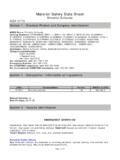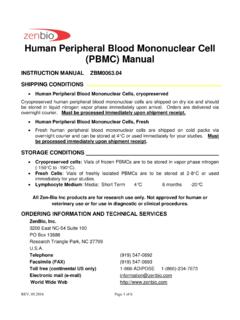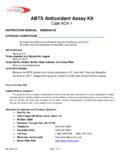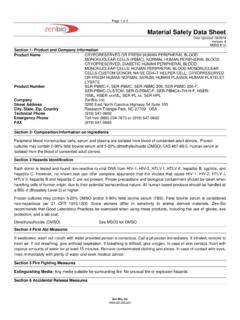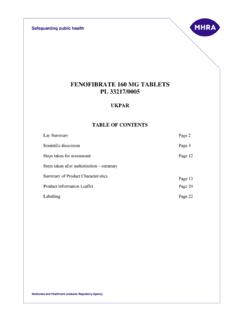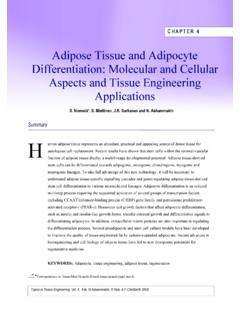Transcription of Rosiglitazone Abrogates Bleomycin-Induced …
1 Matrix PathobiologyRosiglitazone Abrogates bleomycin -InducedScleroderma and Blocks profibrotic ResponsesThrough peroxisome proliferator -ActivatedReceptor- Minghua Wu, Denisa S. Melichian, Eric Chang,Matthew Warner-Blankenship, Asish K. Ghosh,and John VargaFrom the Section of Rheumatology, Northwestern UniversityFeinberg School of Medicine, Chicago, IllinoisThe nuclear hormone receptor, peroxisome prolif-erator- activated receptor (PPAR)- , originally iden-tified as a key mediator of adipogenesis, is ex-pressed widely and implicated in diverse natural and synthetic agonists ofPPAR- abrogated the stimulation of collagen synthe-sis and myofibroblast differentiation induced bytransforming growth factor (TGF)- in vitro. To char-acterize the role of PPAR- in the fibrotic processinvivo, the synthetic agonist Rosiglitazone was used in amouse model of scleroderma .
2 Rosiglitazone attenu-ated Bleomycin-Induced skin inflammation and der-mal fibrosis as well as subcutaneous lipoatrophy andcounteracted the up-regulation of collagen gene ex-pression and myofibroblast accumulation in the le-sioned treatment reduced the in-duction of the early-immediate transcription factorEgr-1in situwithout also blocking the activation ofSmad2/3. Inboth explanted fibroblasts and skin organcultures, Rosiglitazone prevented thestimulation ofcollagen gene transcription and cell migration elic-ited by TGF- . Rosiglitazone -driven adipogenic dif-ferentiation of both fibroblasts and preadipocyteswas abrogated in the presence of TGF- ; this effectwas accompanied by the concomitant down-regula-tion of cellular PPAR- mRNA , these results indicate that Rosiglitazone treat-ment attenuates inflammation, dermal fibrosis, andsubcutaneous lipoatrophy via PPAR- in a mousemodel of scleroderma and suggest that pharmacolog-ical PPAR- ligands, widely used as insulin sensitizersin the treatment of type-2 diabetes mellitus, may bepotential therapies for scleroderma .
3 (Am J Pathol2009, 174:519 533; DOI: )Excessive collagen accumulation in the skin and lungs,the hallmark of systemic sclerosis (SSc), can lead toorgan dysfunction, failure, and pathogenesisof fibrosis remains incompletely is a prevalent early feature, its precise rolein fibrosis remains controversial, and anti-inflammatorytherapies are generally ineffective in reversing or slowingthe progression of the , there is anurgent need for anti-fibrotic therapies. The fibroblast isthe key effector cell driving the fibrotic process in SSc. Inresponse to extracellular cues such as transforminggrowth factor (TGF)- , fibroblasts become activated withincreased collagen production, expression of cell surfacereceptors for growth factors, secretion of cytokines andchemokines, resistance to apoptosis induction, and myo-fibroblast light of the key role of TGF- in the pathogenesis of fibrosis, therapeutic strategies toblock its production, activity, or intracellular signaling areunder , because the potent anti-inflammatory and immunosuppressive activities of TGF- are physiologically important, global TGF- blockadecould be complicated by spontaneous autoimmunity.
4 In-deed, mice lacking TGF- die at an early age from , an ideal anti-fibrotic strategytargeting TGF- must selectively abrogate fibrotic re-sponses without disrupting its important immunosuppres-sive is an insulin-sensitizing agent widely intype 2 diabetes mellitus that exerts its biological effects inSupported by the National Institutes of Health (National Institute of Arthritisand Musculoskeletal and Skin Diseases grants AR-42309 and AR-49025)and the scleroderma Research for publication November 4, reprint requests to John Varga, Section of Rheumatology,Northwestern University Feinberg School of Medicine, 240 E. Huron St.,Chicago IL 60611. E-mail: American Journal of Pathology, Vol. 174, No. 2, February 2009 Copyright American Society for Investigative PathologyDOI: via the peroxisome proliferator activated receptor(PPAR).
5 7 Originally identified in adipose tissue, PPAR- is one of a family of closely related nuclear receptors andligand- activated transcription factors with a primary rolein addition to adipocytes, PPAR- isexpressed in macrophages, vascular endothelial andsmooth muscle cells, and fibroblasts. The PPAR- recep-tor acts as a lipid sensor that can be activated by fattyacids, eicosanoids, and related endogenous products majority of experimental studies ofPPAR- have used the natural ligand 15-deoxy- 12,14prostaglandin J2(15d-PGJ2), or synthetic ligands suchas Rosiglitazone . In theabsence of ligand, PPAR- is com-plexed to the retinoid X receptor (RXR) and co-repressors,preventing its binding to DNA. Upon receptor ligation, co-repressors are displaced from the PPAR- /RXR complexand co-activators such as p300 are recruited,allowingsequence-specific binding to conserved PPAR- re-sponse elements (PPREs)
6 In target gene of PPAR- exert a broad range of proliferative,anti-inflammatory, and repair activities in addition to ad-ipogenesis and insulin studieshave shown that PPAR- inhibits basal and stimulatedcollagen synthesisin vitroandin vivo, suggesting a novelbiological role in connective tissue 14Li-gand inhibition of TGF- -dependent fibrotic responseswas mediated via the PPAR- receptor and involved an-tagonistic cross talk with the intracellular TGF- /Smadsignal transduction fibroblast activation by TGF- is a key patho-genetic event in SSc, blockade of TGF- signaling byPPAR- could be a novel therapeutic approach to patho-logical fibrogenesis. In the present studies, therefore, weinvestigated the effect of Rosiglitazone , the most potentpharmacological PPAR- agonist, in bleomycin -inducedscleroderma.
7 The results indicate that Rosiglitazone ame-liorated the development of fibrosis in this mouse modelof scleroderma . The anti-fibrotic effect of rosiglitazoneinvolved blockade of TGF- - induced fibroblast activa-tion, as well as attenuation of the inflammatory , Rosiglitazone counteracted the develop-ment of subcutaneous adipose atrophy and loss of localPPAR- expression. Together, these findings indicatethat ligands of PPAR- , already in clinical use for thetreatment of type 2 diabetes mellitus, block fibrotic TGF- responses without triggering aberrant immunity, suggest-ing their potential as novel anti-fibrotic agents in and MethodsAnimals and Experimental ProtocolsSix- to eight-week-old female BALB/c mice (The JacksonLaboratory, Bar Harbor, ME) were used in these protocols were institutionally approved by the North-western University Animal Care and Use were housed in autoclaved cages and fed sterilefood and water.
8 Filter-sterilized bleomycin [20 g/mouse dissolved in phosphate-buffered saline (PBS)](Mayne Pharma, Paramus, NJ) or PBS was adminis-tered by daily subcutaneous injections into the shavedbacks of mice using a 27-gauge (5 mg/kg) (GlaxoSmithKline, King of Prussia, PA)and the irreversible PPAR- antagonist GW9662 (Bi-omol International, Plymouth Meeting, PA) were admin-istrated by daily intraperitoneal injection. At the end ofeach experiment, mice were sacrificed and lesionalskin was processed for analysis. Each experimentalgroup consisted of at least five AnalysisLesional skin tissue was embedded in paraffin, and con-secutive 4- m serial sections were stained with hematox-ylin and eosin (H&E).
9 To evaluate collagen content andorganization in the lesional skin, deparaffinized sectionswere stained with Picrosirius Red and viewed under apolarized light thickness, definedas the distance between the epidermal-dermal junctionand the dermal-adipose layer junction, and the adi-pose layer, defined as the distance between the der-mal-adipose junction and the muscle, was determinedin H&E-stained sections at 100 microscopic magnifi-cation. For localizing tissue lipids, samples immersedin freezing medium (Triangle Biomedical Sciences,Durham, NC) were sectioned (7 m) using a CM 1900UV cryostat (Leica Microsystems, Bannockburn, IL)and stained with Oil Red cells were identifiedby Astra blue staining and quantified by counting in sixrandom fields under high detectapoptosis, terminal dUTP nick-end labeling (TUNEL)assays were performed on paraffin-embedded tissuesusing anin situcell death detection kit (Roche Molec-ular Biochemicals, Indianapolis, IN).
10 Immunohistochemistry andImmunofluorescenceFour- m sections from lesional skin were deparaffinized,rehydrated, and immersed in TBS-T buffer (Tris-bufferedsaline and Tween 20), and treated with target re-trieval solution (DAKO, Carpinteria, CA) at 95 C for 10minutes. Tissue embedded in freezing medium (TriangleBiomedical Sciences) was sectioned (7 m) in a CM1900 UV cryostat. Primary antibodies against CD3 (BDPharmingen, San Diego, CA); Mac-3 (BD Pharmingen), -smooth muscle actin (Sigma-Aldrich, St. Louis, MO),TGF- 1 and Egr-1 (both from Santa Cruz Biotechnology,Santa Cruz, CA), phospho-Smad2 (Cell Signaling, Dan-vers, MA), PPAR- (Santa Cruz), or I-Ad(BD Pharmingen)were antibodies were detected usingsecondary antibodies from the Histomouse-Max kit(Zymed Laboratories, San Francisco, CA) and the DakoCy-tomation Envision System-HRP (3,3 -diaminobenzidinetetrahydrochloride)acco rding to the manufacturers in-structions.
